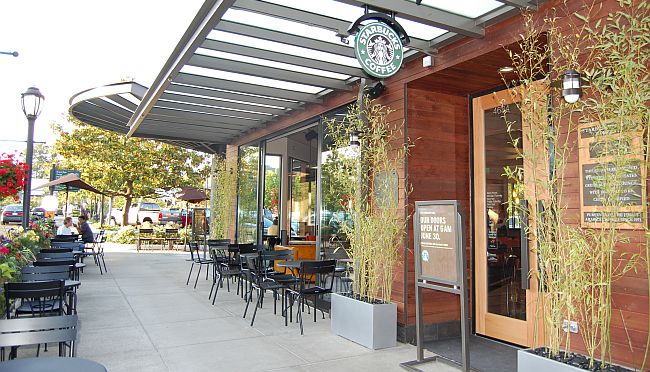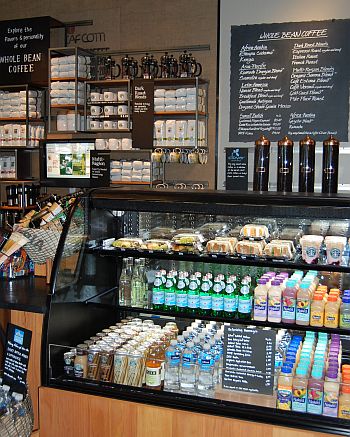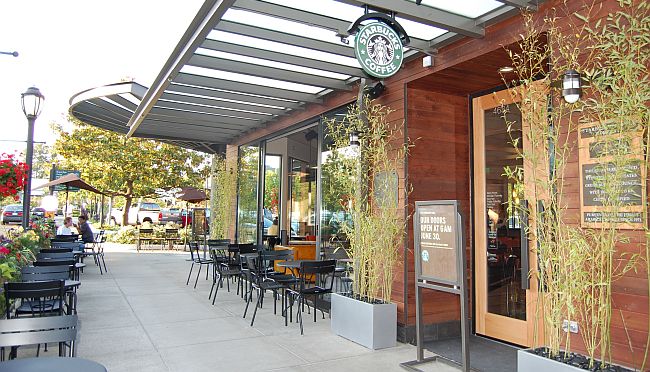 Photo: Sarah van SchagenStroll into the newly renovated Starbucks coffeehouse in Seattle’s University Village and the décor may feel more familiar than you’d expect.
Photo: Sarah van SchagenStroll into the newly renovated Starbucks coffeehouse in Seattle’s University Village and the décor may feel more familiar than you’d expect.
The menu boards are made from the chalkboards you may have scribbled on at nearby Garfield High School; the shelving is from old bleachers you may have sat upon; the leather accents near the bar are from your old shoes and car seats; and the ash-wood community table that stretches the length of the store and patio (one-third of it is outside) is salvaged from a tree that fell in Seattle’s Wallingford neighborhood.
It’s part of an effort to create a shared sense of community while reducing impact on the planet — all by sourcing materials locally. But it’s no one-off show-off. The University Village store is actually one of three pilot locations (another in Seattle is on the corner of 1st Ave. and Pike St., and a third is in Paris Disney Village in Paris, France) for the company’s new global store design strategy.
That strategy, which is part of the brand’s Shared Planet initiative, also involves employing local artisans and craftsmen and incorporating reused and recycled materials as much as possible. All of which will help the stores achieve LEED green building certification — the goal for all new company-owned stores built and renovated beginning in 2010.
 Photo: Sarah van Schagen“This green store vision for the company has been happening and building in momentum for several years now,” says Jim Hanna, director of environmental impact for Starbucks. “When we ran our carbon footprint, it basically said that 75 percent of our total carbon footprint is operation of our stores … so if we were really going to have an impact on reducing our footprint, we had to start with the stores.”
Photo: Sarah van Schagen“This green store vision for the company has been happening and building in momentum for several years now,” says Jim Hanna, director of environmental impact for Starbucks. “When we ran our carbon footprint, it basically said that 75 percent of our total carbon footprint is operation of our stores … so if we were really going to have an impact on reducing our footprint, we had to start with the stores.”
And this particular store, which reopened to coffeehounds at 6 a.m. this morning, is the company’s second busiest globally, which makes it a perfect location for testing the green design concepts. One of those new elements is the lighting: Unhappy with the LED options available on the market, Starbucks partnered with GE to create an LED light fixture that wouldn’t be so harsh.
And while the new GE lights are only available to Starbucks right now, they may eventually make it to the mass market. It’s a good example of how the company is using its size for good, Hanna says — not unlike Wal-Mart and other massive global brands that are often villainized, but can create major change in the market when they put their minds to it.
“A lot of our stores have a relatively similar footprint to people’s homes,” Hanna said. “So if somebody sees a cool LED lighting bank in the store, that’s something they can take home and use in their house to reduce their energy usage.”
The same could be said for the dual-flush toilets, which are already in use in all of their Australian locations. “It’s interesting,” says Starbucks Corporate Architect Tony Gale, “people come out of those coffeehouses and that’s what they’re talking about — the dual-flush toilets.”
In an effort to shepherd this sort of take-home messaging, Starbucks is adding explanatory signage throughout the stores to highlight the sustainable elements.
“Our new design actually gives the community a way to learn a little bit more about it as they discover it and maybe take some of those behaviors back to their homes,” says Liz Muller, director of global concept design. “It becomes more of a lab for taking care of our planet.”



